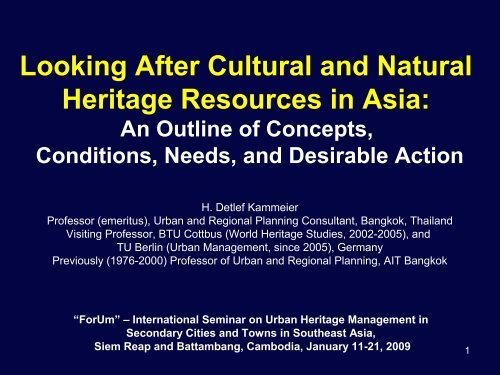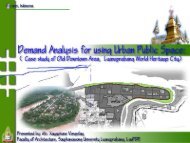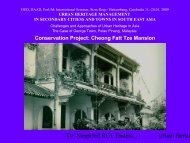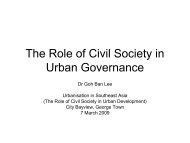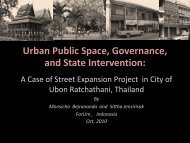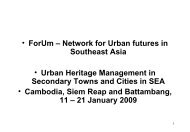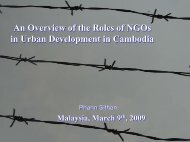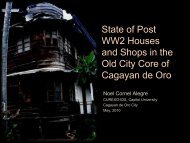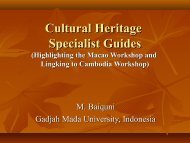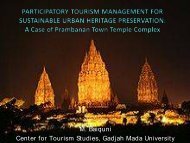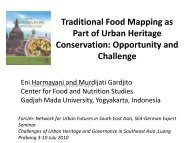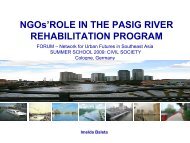Looking After Cultural and Natural Heritage Resources in Asia ...
Looking After Cultural and Natural Heritage Resources in Asia ...
Looking After Cultural and Natural Heritage Resources in Asia ...
You also want an ePaper? Increase the reach of your titles
YUMPU automatically turns print PDFs into web optimized ePapers that Google loves.
<strong>Look<strong>in</strong>g</strong> <strong>After</strong> <strong>Cultural</strong> <strong>and</strong> <strong>Natural</strong><br />
<strong>Heritage</strong> <strong>Resources</strong> <strong>in</strong> <strong>Asia</strong>:<br />
An Outl<strong>in</strong>e of Concepts,<br />
Conditions, Needs, <strong>and</strong> Desirable Action<br />
H. Detlef Kammeier<br />
Professor (emeritus), Urban <strong>and</strong> Regional Plann<strong>in</strong>g Consultant, Bangkok, Thail<strong>and</strong><br />
Visit<strong>in</strong>g Professor, BTU Cottbus (World <strong>Heritage</strong> Studies, 2002-2005), <strong>and</strong><br />
TU Berl<strong>in</strong> (Urban Management, s<strong>in</strong>ce 2005), Germany<br />
Previously (1976-2000) Professor of Urban <strong>and</strong> Regional Plann<strong>in</strong>g, AIT Bangkok<br />
“ForUm” – International Sem<strong>in</strong>ar on Urban <strong>Heritage</strong> Management <strong>in</strong><br />
Secondary Cities <strong>and</strong> Towns <strong>in</strong> Southeast <strong>Asia</strong>,<br />
Siem Reap <strong>and</strong> Battambang, Cambodia, January 11-21, 2009<br />
1
1. Introduction: Reflections on the Context<br />
2. World <strong>Heritage</strong> as a Global Responsibility<br />
3. Locally Based Management<br />
4. Typology of Sites <strong>and</strong> Site Conditions<br />
5. Pr<strong>in</strong>ciples of Good <strong>Heritage</strong> Site Management<br />
6. Conclusions<br />
WH 2007 BORDEAUX<br />
2
Reflections on the context of this sem<strong>in</strong>ar<br />
The context:<br />
• A good idea to run a<br />
sem<strong>in</strong>ar <strong>in</strong> Cambodia<br />
• “Eye opener” <strong>and</strong><br />
exchange of experience<br />
from several countries<br />
• Intention to go for a<br />
second stage as soon as<br />
possible…<br />
The speaker:<br />
• It is an honour <strong>and</strong> an<br />
obligation to speak here<br />
• In SE <strong>Asia</strong> s<strong>in</strong>ce 1972<br />
• Broad academic <strong>and</strong><br />
practical experience <strong>in</strong><br />
many countries<br />
• Specific <strong>in</strong>terests <strong>in</strong><br />
<strong>in</strong>tegrated heritage<br />
conservation for decades<br />
We have ten days together<br />
I have been asked to speak several times<br />
So I do not have to say everyth<strong>in</strong>g up front…<br />
3
Mission <strong>and</strong> scope of the first presentation<br />
• The purpose of the open<strong>in</strong>g speech is to outl<strong>in</strong>e the context of<br />
heritage conservation <strong>in</strong> <strong>Asia</strong>n countries<br />
• The focus of my talks this week is on the management of<br />
heritage sites (with/without World <strong>Heritage</strong> status) <strong>in</strong><br />
develop<strong>in</strong>g countries as well as “transition countries”<br />
• “Complex sites” <strong>in</strong>clude (1) historic cities or city cores as<br />
much as (2) cultural l<strong>and</strong>scapes <strong>and</strong> (3) natural sites – both of<br />
the latter are usually <strong>in</strong>habited by people who are capable <strong>and</strong><br />
will<strong>in</strong>g of tak<strong>in</strong>g care of their areas<br />
• Attention to the specific problems <strong>in</strong> develop<strong>in</strong>g or “transition<br />
countries” where conservation <strong>and</strong> “revitalization” of historic<br />
cities (or conservation of nature areas) are <strong>in</strong> a tough<br />
competition with economic growth <strong>and</strong> the development of<br />
basic social needs<br />
4
A sample of WHS –<br />
Huge differences<br />
<strong>in</strong> content, type, <strong>and</strong> size…<br />
Any common characteristics?<br />
5<br />
All pix from WH website
1. Introduction: Reflections on the Context<br />
2. [World] <strong>Heritage</strong> as a Global Responsibility<br />
3. Locally Based Management<br />
4. Typology of Sites <strong>and</strong> Site Conditions<br />
5. Pr<strong>in</strong>ciples of Good <strong>Heritage</strong> Site Management<br />
6. Conclusions<br />
WH 2007 JEJU DO<br />
6
Global responsibility – taken seriously?<br />
• The “global responsibility” may well be referred to <strong>in</strong> big<br />
UN documents (WH List s<strong>in</strong>ce 1972!), but it is certa<strong>in</strong>ly<br />
not yet a fully developed global movement<br />
• Two very tough tests,<br />
• Tak<strong>in</strong>g overall responsibility at national level, <strong>and</strong><br />
• Translat<strong>in</strong>g global responsibility <strong>in</strong>to local action<br />
• In pr<strong>in</strong>ciple, this is similar to the situation <strong>in</strong> the globallocal<br />
environmental agenda (LA 21) <strong>in</strong> the 1980s <strong>and</strong> 90s<br />
7
Culture <strong>and</strong> nature <strong>in</strong>tertw<strong>in</strong>ed:<br />
The <strong>in</strong>creas<strong>in</strong>g complexity of “heritage sites”<br />
Ecosystem<br />
<strong>Cultural</strong> l<strong>and</strong>scape, historic city<br />
<strong>Heritage</strong> site<br />
Monument<br />
Both cultural l<strong>and</strong>scapes <strong>and</strong> historic cities must facilitate adequate<br />
<strong>in</strong>volvement of the local community as the traditional “site owner”. This<br />
requires special <strong>in</strong>stitution-build<strong>in</strong>g <strong>and</strong> social policies at the local level,<br />
but also fund<strong>in</strong>g support at all levels of government<br />
8
INTANGIBLE<br />
TANGIBLE<br />
NATURAL MAN-MADE<br />
Phenomena Activities<br />
<strong>Natural</strong> Objects Artefacts<br />
<strong>Cultural</strong> / Social<br />
Movable / Immovable<br />
Comprehensive def<strong>in</strong>ition of heritage resources:<br />
‘Integrated’ conservation must <strong>in</strong>clude the <strong>in</strong>tangible activities<br />
9
historic cities<br />
(170 WHS)<br />
CULTURE<br />
878 WHS (2008) >>> 1000, <strong>in</strong>flation…?<br />
679 cultural – 25 mixed – 174 natural sites<br />
Protected historic city sites:<br />
50…100,000? (ICOMOS <strong>and</strong> others)<br />
cultural l<strong>and</strong>scapes<br />
(130 WHS)<br />
NATURE<br />
Protected natural sites: 68,000<br />
(various IUCN categories)<br />
10
The focus of our sem<strong>in</strong>ar<br />
<strong>Heritage</strong> protection <strong>in</strong><br />
Southeast <strong>Asia</strong><br />
• Great diversity of<br />
countries – relatively rich<br />
<strong>and</strong> quite poor<br />
• National policy priorities<br />
not on conservation<br />
• But: Important entry<br />
po<strong>in</strong>ts: Tourism!<br />
Environment!<br />
• Huge new opportunities<br />
from regional cooperation<br />
<strong>and</strong> exchange<br />
• Secondary cities <strong>and</strong><br />
towns<br />
• Urban conservation still<br />
new <strong>in</strong> <strong>Asia</strong> (compared<br />
with “the West”)<br />
• Urban conservation less<br />
understood than<br />
monument preservation<br />
• Smaller cities more<br />
neglected that larger<br />
ones<br />
• Local conditions Siem<br />
Reap quite different from<br />
Battambang<br />
11
1. Introduction: Reflections on the Context<br />
2. World <strong>Heritage</strong> as a Global Responsibility<br />
3. Locally Based Management<br />
4. Typology of Sites <strong>and</strong> Site Conditions<br />
5. Pr<strong>in</strong>ciples of Good <strong>Heritage</strong> Site Management<br />
6. Conclusions<br />
WH 2007 JINJIANGLI<br />
12
Management of (world) heritage:<br />
pr<strong>in</strong>cipal division of responsibilities<br />
Levels: From global to local<br />
(<strong>and</strong> <strong>in</strong>dividual l<strong>and</strong> <strong>and</strong><br />
bus<strong>in</strong>ess owners)<br />
Global: UNESCO WHC<br />
(supported by ICOMOS,<br />
ICCROM, IUCN, et al)<br />
National: “State parties”<br />
(federal / national, state)<br />
Regional / local:<br />
“site management authority”<br />
Public bodies’ pr<strong>in</strong>cipal roles Partners<br />
Guidel<strong>in</strong>es, promotion of best<br />
practices, comparative monitor<strong>in</strong>g,<br />
limited seed fund<strong>in</strong>g<br />
Policies, guidel<strong>in</strong>es, best practices,<br />
monitor<strong>in</strong>g<br />
Reconcil<strong>in</strong>g WH guidel<strong>in</strong>es <strong>and</strong><br />
national legislation<br />
Fund<strong>in</strong>g support<br />
Local-level plann<strong>in</strong>g / management,<br />
Local <strong>in</strong>stitution-build<strong>in</strong>g, legislation,<br />
<strong>and</strong> co-fund<strong>in</strong>g<br />
Facilitat<strong>in</strong>g private-sector co-operation<br />
<strong>and</strong> co-fund<strong>in</strong>g<br />
Global NGO <strong>and</strong><br />
special <strong>in</strong>terest<br />
groups<br />
Professional groups,<br />
city associations,<br />
foundations<br />
Local foundations<br />
<strong>and</strong> associations,<br />
<strong>in</strong>dividual property<br />
owners<br />
13
<strong>Natural</strong> Sites: Better<br />
protection of nature<br />
under threat from<br />
civilization?<br />
• 84% of the national parks (<strong>in</strong> Lat<strong>in</strong><br />
America) are <strong>in</strong>habited by <strong>in</strong>digenous<br />
peoples;<br />
• 90% of protected areas <strong>in</strong> Europe<br />
are seasonally used by pastoral<br />
people graz<strong>in</strong>g their flocks.<br />
• But - Indigenous practices have<br />
proven to be successful,<br />
• they can produce similar results as<br />
Western approaches, they can be<br />
<strong>in</strong>expensive, <strong>and</strong> easier to enforce<br />
14
What exactly is a “management plan” for<br />
(a complex) World <strong>Heritage</strong> Site (1)?<br />
1. Protect<strong>in</strong>g the site aga<strong>in</strong>st external <strong>in</strong>fluences – need<br />
for develop<strong>in</strong>g better cultural impact assessment methods<br />
2. Emphasis on management rather than physical design<br />
• “Management” <strong>in</strong>cludes appropriate <strong>in</strong>stitutional<br />
arrangements (at the local level <strong>and</strong> above it)<br />
• This implies an emphasis on implementation, which<br />
• presupposes suitable shar<strong>in</strong>g of the heavy f<strong>in</strong>ancial<br />
burdens of urban conservation<br />
3. The guidel<strong>in</strong>es of the WH Centre for management plans<br />
encompass all those po<strong>in</strong>ts<br />
15
What exactly is a “management plan” for a<br />
historic city as a World <strong>Heritage</strong> Site (2)?<br />
• There are some (but not many) good examples of<br />
management plans to refer to (UK, Australia, e.g.)<br />
• Most historic cities are not World <strong>Heritage</strong> Sites, but the<br />
WH guidel<strong>in</strong>es are nevertheless always useful to refer to<br />
• “Conservation counts (<strong>and</strong> it pays)”: If properly done,<br />
public <strong>in</strong>vestments usually trigger considerable private<br />
<strong>in</strong>vestments >>> Estimated multipliers <strong>in</strong> urban areas are at<br />
least 1:3 but may reach 1:6!<br />
• Properly managed “revitalization” (which is not so much<br />
the problem <strong>in</strong> Cambodian towns!) must mean a mix of<br />
economic, social, <strong>in</strong>stitutional, <strong>and</strong> physical improvements<br />
16
Property<br />
ownership<br />
Public sector<br />
Streets<br />
Open spaces<br />
Plots/Build<strong>in</strong>gs<br />
Private sector<br />
Owner-occupied<br />
Plots/Build<strong>in</strong>gs<br />
Fully developed f<strong>in</strong>anc<strong>in</strong>g system for urban conservation areas<br />
Cost categories Form of fund<strong>in</strong>g Sources of fund<strong>in</strong>g Remarks<br />
- Acquisition<br />
- Major renovation,<br />
repairs<br />
New <strong>in</strong>frastructure<br />
construction<br />
Ma<strong>in</strong>tenance Recurrent expenses<br />
(of respective public<br />
agency)<br />
L<strong>and</strong> acquisition - Private <strong>in</strong>vestment<br />
- Special low-<strong>in</strong>terest<br />
loans<br />
- No charges for<br />
public <strong>in</strong>frastructure<br />
improvements<br />
Construction - Private fund<strong>in</strong>g<br />
- Low-<strong>in</strong>terest loans<br />
- Public subsidies<br />
- Tax deduction<br />
To be elaborated later <strong>in</strong> this course<br />
Ma<strong>in</strong>tenance - Private<br />
- Tax holidays or<br />
reduced tax<br />
Rented property Rental payments - Public subsidies for<br />
needy residents<br />
Capital <strong>in</strong>vestment - Specific national grant<br />
- Annual budget of agency <strong>in</strong> charge<br />
of heritage sites<br />
- Special lottery proceeds<br />
- Special fund rais<strong>in</strong>g measures<br />
Capital <strong>in</strong>vestment - Federal, state, municipal cofund<strong>in</strong>g<br />
- Revenues from rent<strong>in</strong>g property<br />
- Entrance fees<br />
- Surcharges on hotel taxes<br />
(“Kurtaxe”)<br />
- Preferential tax arrangements for<br />
conservation areas<br />
- National funds earmarked for<br />
conservation areas<br />
- Preferential tax arrangements for<br />
conservation <strong>and</strong> environmental<br />
projects<br />
- Preferential tax arrangements<br />
with<strong>in</strong> 15-20 years after construction<br />
Legal tool for<br />
acquisition right of<br />
“first refusal” of local<br />
authority<br />
Entrance fees for<br />
foreign tourists, e.g.<br />
<strong>After</strong> the end of the<br />
conservation<br />
programme (20-25<br />
years), charges for<br />
<strong>in</strong>frastructure<br />
improvements<br />
17
Awards to private-public projects <strong>in</strong><br />
Gilgit (Pakistan), Lijiang (Ch<strong>in</strong>a)<br />
Annual competition s<strong>in</strong>ce 2000<br />
Book publication 2007<br />
18
The Programme of the <strong>Asia</strong><br />
Pacific Awards for <strong>Cultural</strong><br />
<strong>Heritage</strong> Conservation has<br />
attracted entries from all over<br />
<strong>Asia</strong> (<strong>in</strong>clud<strong>in</strong>g Australia).<br />
The restoration of this rural wat<br />
<strong>in</strong> NE Thail<strong>and</strong> was a 100%<br />
community project.<br />
19
To be elaborated later <strong>in</strong> this course<br />
Application brochures available<br />
Contrast<strong>in</strong>g APH Awards, 2007: Temple<br />
management by community (Ladakh,<br />
India); architectural <strong>in</strong>tegration &<br />
<strong>in</strong>novation (Hong Kong)<br />
www.unescobkk.org/<br />
20
An <strong>in</strong>dependent example from Thail<strong>and</strong><br />
Local community action for the traditional l<strong>and</strong>scape <strong>in</strong> Nonthaburi (Greater Bangkok) 21
1. Introduction: Reflections on the Context<br />
2. World <strong>Heritage</strong> as a Global Responsibility<br />
3. Locally Based Management<br />
4. Typology of Sites <strong>and</strong> Site Conditions<br />
5. Pr<strong>in</strong>ciples of Good <strong>Heritage</strong> Site Management<br />
6. Conclusions<br />
WH 2007 SHI LIN<br />
22
Towards a typology of WHS for facilitat<strong>in</strong>g<br />
better management<br />
Purpose: To dist<strong>in</strong>guish groups of sites with comparable<br />
characteristics to facilitate work<strong>in</strong>g exchange relations<br />
(example: WH cities, or cultural l<strong>and</strong>scapes – but that is<br />
still too broad)<br />
Helpful criteria of comparability: <strong>Cultural</strong> region, economic<br />
development of the country, common historical features<br />
Similar places: Population size, physical fabric, ethnicity,<br />
climate, adm<strong>in</strong>istrative set-up, tourism potential<br />
Based on such criteria, exchange <strong>and</strong> co-operation<br />
arrangements would be quite promis<strong>in</strong>g<br />
All this requires a good database for comparative analysis<br />
>>> refer to the annex (perhaps later <strong>in</strong> the course)<br />
23
Very diverse “liv<strong>in</strong>g historic cities” –<br />
How much do they have <strong>in</strong> common?<br />
Selected WHS <strong>in</strong> Ch<strong>in</strong>a, Yemen, Uzbekistan, Lithuania, Germany<br />
24<br />
All pix from WH website
Know<strong>in</strong>g the typical problems associated with<br />
heritage areas – as a basis for remedial action<br />
• Discrepancy of values (economic vs emotional / cultural, e.g.)<br />
• Discrepancies between the public <strong>in</strong>terest <strong>and</strong> many different<br />
private <strong>in</strong>terests (l<strong>and</strong> owners <strong>and</strong> their f<strong>in</strong>ancial ability)<br />
• Local-national clashes on values <strong>and</strong> development<br />
• Threats (neglect, decay, <strong>in</strong>considerate policies, <strong>in</strong>compatible<br />
new development)<br />
• Risks (to be prepared for)<br />
25
Dist<strong>in</strong>guish<strong>in</strong>g values <strong>and</strong> their discrepancies<br />
Emotional Values Wonder<br />
Identity<br />
Cont<strong>in</strong>uity<br />
Spiritual <strong>and</strong> symbolic<br />
<strong>Cultural</strong> Values<br />
Note: Ecological<br />
Values are of a<br />
comparable nature!<br />
Documentary<br />
Historic<br />
Archaeological, age <strong>and</strong> scarcity<br />
Aesthetic <strong>and</strong> symbolic<br />
Architectural<br />
Townscape, l<strong>and</strong>scape, ecological<br />
Technological <strong>and</strong> scientific<br />
Use Values Functional<br />
Economic<br />
Social<br />
Political <strong>and</strong> ethnic<br />
To be elaborated later <strong>in</strong> this course<br />
Source: Feilden<br />
26
Qualitatively /<br />
quantitatively<br />
measured<br />
values<br />
Present po<strong>in</strong>t <strong>in</strong> time<br />
Public view of historic values<br />
Typical problems: Loss of cultural identity (<strong>and</strong><br />
loss of appreciation of traditional values) – to<br />
be addressed by conservation efforts<br />
Experts’ views<br />
Re-appreciation<br />
of public views<br />
WH or nat’l<br />
heritage status<br />
Time<br />
27
Qualitatively /<br />
quantitatively<br />
measured<br />
values<br />
Use value<br />
Historic value<br />
The pr<strong>in</strong>cipal problem: Obsolescence<br />
Present po<strong>in</strong>t <strong>in</strong> time<br />
Revitalization,<br />
rehabilitation,<br />
adaptive re-use<br />
Time<br />
Remedial action: Conservation, but not re-development<br />
28
Typical opportunities<br />
• Tourism (various types) as an obvious future for many<br />
heritage sites – but… great dangers of overcrowd<strong>in</strong>g <strong>and</strong><br />
loss of heritage values<br />
• <strong>Cultural</strong> events (concerts, theater, other shows) as a<br />
creative solution with considerable employment effects, but<br />
-- seasonal peaks (summer) <strong>and</strong> troughs<br />
• “Knowledge <strong>in</strong>dustries” (special university <strong>in</strong>stitutes,<br />
<strong>in</strong>ternational exchange centres, <strong>in</strong>ternational schools) with<br />
remarkable potential for susta<strong>in</strong>able employment effects<br />
• Conference <strong>and</strong> cultural tourism – as a better solution than<br />
seasonal mass tourism (if conference facilities <strong>and</strong><br />
knowledge <strong>in</strong>dustries can be put <strong>in</strong> place)<br />
29
1. Introduction: Reflections on the Context<br />
2. World <strong>Heritage</strong> as a Global Responsibility<br />
3. Locally Based Management<br />
4. Typology of Sites <strong>and</strong> Site Conditions<br />
5. Pr<strong>in</strong>ciples of Good <strong>Heritage</strong> Site Management<br />
6. Conclusions<br />
WH 2007 ATSINANANA<br />
30
The Burra Charter * >> one of<br />
the best <strong>in</strong>ternationally<br />
applicable guidel<strong>in</strong>es<br />
The process is adaptable, multidiscipl<strong>in</strong>ary,<br />
<strong>and</strong><br />
management-focused<br />
Ma<strong>in</strong> characteristics of a<br />
strategic approach:<br />
1. L<strong>in</strong>k<strong>in</strong>g science <strong>and</strong> action<br />
2. Multi-criteria analysis<br />
3. Options for <strong>in</strong>tervention<br />
4. Participation / consultation<br />
5. Iterative processes<br />
_____________________________<br />
* Refer to website of ICOMOS Australia<br />
31
WHS Management Plans<br />
• Good management plans are issues-focused <strong>and</strong> action<br />
oriented, with strong emphasis on the <strong>in</strong>stitutional<br />
framework <strong>and</strong> implementation<br />
• A typical example of a good management plan from the<br />
UK is the one for…<br />
• Ironbridge Gorge, which is structured much <strong>in</strong> the same<br />
way as most of the other UK-based management plans<br />
for urban conservation situations or cultural l<strong>and</strong>scapes<br />
• The Australian plan for Uluru (Ayers Rock) is a good one<br />
for a cultural l<strong>and</strong>scape<br />
• IUCN is actively <strong>in</strong>volved <strong>in</strong> promot<strong>in</strong>g community based<br />
areas with local management<br />
32
Good examples of plans, proven “best practices” –<br />
as <strong>in</strong> urban environmental plann<strong>in</strong>g (ICLEI e.g.), to<br />
enable the heritage manager to develop…<br />
• Strategic plann<strong>in</strong>g qualities<br />
• Community <strong>in</strong>volvement <strong>and</strong> ownership of the plan<br />
• Integration with exist<strong>in</strong>g <strong>in</strong>stitutional framework <strong>and</strong><br />
exist<strong>in</strong>g statutory (<strong>and</strong> other) plans<br />
• Appropriate analytical tools<br />
• Computer-aided tools --- database management, analytical<br />
cartography (GIS) <strong>and</strong> CAD, but also<br />
• Appropriate communication tools for keep<strong>in</strong>g the<br />
community <strong>in</strong>formed <strong>and</strong> <strong>in</strong>volved<br />
33
ICT opportunities for the management<br />
of heritage sites<br />
• Internet-based <strong>in</strong>formation flows <strong>and</strong> comput<strong>in</strong>g are<br />
universally applicable<br />
• Computer applications <strong>in</strong> urban <strong>and</strong> regional plann<strong>in</strong>g<br />
<strong>and</strong> management now very common<br />
• City market<strong>in</strong>g, <strong>in</strong>ternet-based tourism market<strong>in</strong>g<br />
• <strong>Heritage</strong> management as an emerg<strong>in</strong>g <strong>in</strong>terdiscipl<strong>in</strong>ary<br />
specialization<br />
• Exist<strong>in</strong>g relevant GIS applications: “Time Map”, ECAI<br />
(electronic cultural atlas <strong>in</strong>itiative)<br />
34
Need for a better WHS database<br />
• Rationale: Wealth of <strong>in</strong>formation on WH, but scattered <strong>and</strong><br />
not readily accessible…<br />
• Competence <strong>in</strong> WHS management <strong>in</strong>creas<strong>in</strong>g too slowly<br />
• Need for more exchange among professionals <strong>and</strong> ”site<br />
managers”<br />
• UNESCO database compris<strong>in</strong>g all 851 sites (as of July<br />
2007): Rich <strong>in</strong>formation, regularly ma<strong>in</strong>ta<strong>in</strong>ed, but…<br />
• Extremely limited search capability – hence <strong>in</strong>adequate<br />
use of the potentially valuable <strong>in</strong>formation, <strong>and</strong> <strong>in</strong>sufficient<br />
exchange among site management officers<br />
• UNESCO copyright on data provided by national agencies<br />
<strong>in</strong> charge, several imitations of UNESCO <strong>in</strong>ternet<br />
database, but…<br />
This might be elaborated later <strong>in</strong> this course<br />
• Better management support by UNESCO WHC needed<br />
<strong>and</strong> possible<br />
35
Miss<strong>in</strong>g l<strong>in</strong>ks – management <strong>in</strong>formation?!<br />
• There is no shortage of excellent guidel<strong>in</strong>es (Internet!) >>><br />
but they are not accessible without specific <strong>and</strong> timeconsum<strong>in</strong>g<br />
search efforts<br />
• Good comparable plans are extremely hard to come by, if<br />
they exist at all…<br />
• Even with<strong>in</strong> the same country, WH management<br />
approaches are not sufficiently co-ord<strong>in</strong>ated to create the<br />
necessary synergies<br />
In view of such difficulties, personal research <strong>in</strong>itiative<br />
(Kammeier at WHS/BTU launched <strong>in</strong> 2005, cont<strong>in</strong>u<strong>in</strong>g):<br />
Electronic database for better management of World<br />
<strong>Heritage</strong> sites >>> refer to the annex of my paper<br />
36
1. Introduction: Reflections on the Context<br />
2. World <strong>Heritage</strong> as a Global Responsibility<br />
3. Locally Based Management<br />
4. Typology of Sites <strong>and</strong> Site Conditions<br />
5. Pr<strong>in</strong>ciples of Good <strong>Heritage</strong> Site Management<br />
6. Conclusions<br />
WH 2007 SYDNEY37
“State of the art” <strong>in</strong> the management of<br />
complex heritage sites<br />
• Considerable <strong>and</strong> often impressive advances –<br />
albeit mostly <strong>in</strong> affluent countries<br />
• Grow<strong>in</strong>g threats but also emerg<strong>in</strong>g opportunities <strong>in</strong><br />
poorer countries<br />
• The “Hoi An Protocols” of 2001 (UNESCO<br />
Bangkok) provide very good <strong>in</strong>formation on<br />
pr<strong>in</strong>ciples � to be discussed <strong>in</strong> the workshops<br />
• In general, the “conservation world” of 2009 is<br />
dist<strong>in</strong>ctly different from that of 40 years ago<br />
(Venice Charter)<br />
• We do have at least some answers to most of the<br />
hard questions, <strong>in</strong>clud<strong>in</strong>g substantial contributions<br />
from <strong>Asia</strong>n countries<br />
38
Further support<strong>in</strong>g the management of<br />
complex heritage sites<br />
Much greater <strong>in</strong>ternational (<strong>and</strong> national) efforts are<br />
needed:<br />
� Protected nature areas vs <strong>in</strong>digenous peoples’ rights<br />
<strong>and</strong> potential roles <strong>in</strong> manag<strong>in</strong>g such resources<br />
� Better <strong>in</strong>tegration <strong>in</strong> ma<strong>in</strong>-stream <strong>in</strong>ternational economic<br />
support programmes<br />
� Develop<strong>in</strong>g realistic, adapted, <strong>and</strong> affordable urban<br />
conservation approaches -- balanc<strong>in</strong>g “protection of the<br />
past” with “support<strong>in</strong>g future development”<br />
Broad scope for targeted exchange of experiences <strong>and</strong><br />
regional tra<strong>in</strong><strong>in</strong>g programmes<br />
39
<strong>Look<strong>in</strong>g</strong> at possible follow-up action after<br />
this sem<strong>in</strong>ar<br />
Secondary cities <strong>in</strong> poor countries cannot wait forever…!<br />
� Action to be taken now<br />
� Better <strong>in</strong>tegration of their conservation potentials <strong>in</strong><br />
ma<strong>in</strong>-stream local plann<strong>in</strong>g <strong>and</strong> management<br />
� Potential help with build<strong>in</strong>g the ma<strong>in</strong> pillars of opportunity<br />
for local programmes:<br />
� Awareness among decision-makers; cooperation by local<br />
property owners; start<strong>in</strong>g with good pilot projects; l<strong>in</strong>k<strong>in</strong>g<br />
tourism, environment, <strong>and</strong> heritage conservation; tapp<strong>in</strong>g<br />
<strong>in</strong>ternational assistance<br />
40
Progress <strong>in</strong> specialized heritage<br />
management education<br />
• Special academic programmes <strong>in</strong> several<br />
countries<br />
• Many conferences, academic journals<br />
• UNESCO’s (<strong>Asia</strong> Pacific) pioneer<strong>in</strong>g efforts<br />
• Positive <strong>in</strong>fluences from neighbour<strong>in</strong>g<br />
countries<br />
• <strong>Asia</strong>n Academy for <strong>Heritage</strong> Management<br />
(UNESCO/ICCROM, s<strong>in</strong>ce 2001)<br />
General conclusion for SE <strong>Asia</strong>:<br />
The “conservation world” is better than ever before, but<br />
much needs to be done <strong>in</strong> <strong>Asia</strong> � SO LET’S DO IT!<br />
41
Thank you for your attention<br />
42


